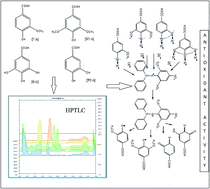HPTLC-densitometric determination and kinetic studies on antioxidant potential of monomeric phenolic acids (MPAs) from Bergenia species
Abstract
The aim of the present communication is the development of validated HPTLC method for simultaneous separation, detection, comparative quantification of monomeric phenolic acids (MPAs), such as vanillic acid (VA), syringic acid (SYA), gallic acid (GA), protocatechuic acid (PCA) in Bergenia species viz. Bergenia ciliata (BC) and Bergenia stracheyi (BS) (Paashanbheda; family Saxifragraceae) and Kinetics studies on antioxidant activity of focused metabolites. The analyses were performed on HPTLC pre-coated silica gel 60F254 plates with optimized solvent system toluene : ethyl acetate : formic acid (5 : 4 : 1 v/v/v) as mobile phase. Densitometric detection of MPAs was performed at 280 nm (λ max) wavelength. The contents of MPAs in both species were found (% in 10 mg ml−1) 0.007 ± 0.1–0.003 ± 0.4 (VA) (y = 3.326x − 1103, regression coefficient r = 0.998), 0.017 ± 0.4 − 0.002 ± 0.5 (SYA) (y = 3.410x − 1009, r = 0.998), 0.024 ± 0.2 − 0.012 ± 0.2 (GA) (y = 5.349x − 240.2, r = 0.999) and 0.027 ± 0.6 − 0.018 ± 0.2 (y = 3.6x − 461.5, r = 0.995). Quantitative variation was assumed as a result of samples collected from different altitudinal range. Two antioxidant assays DPPH and β-carotene were used kinetically in antioxidant potential assessment. Among both the species BC had higher DPPH antioxidant activity and antiradical kinetics than BS, MPAs and positive controls (TOCO), (BHT). Whilst in β-carotene assay highest antiradical activity was reported in PCA kinetically despite BHT than others. However, the deviation in CAA values of BC and BS extracts were very close to the PCA value. EC50 values, rate constant (k), rate of reaction (dx/dt), half-life and average life were also measured in both assays. On the basis of finding it can be concluded that the investigated MPAs were actively involved in antioxidant properties. The kinetic studies of MPAs revealed that H atom transfer from phenolic moieties to the ROS predicts the reactivity of antioxidants.


 Please wait while we load your content...
Please wait while we load your content...